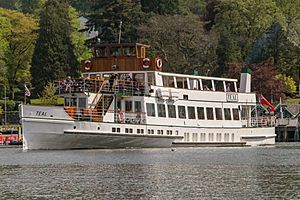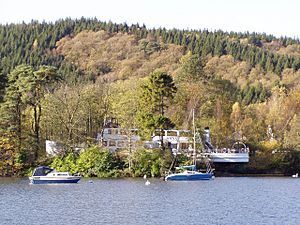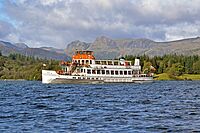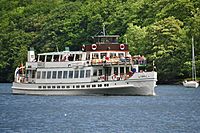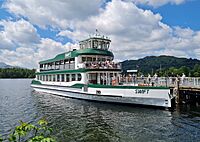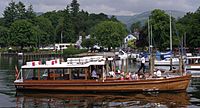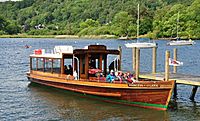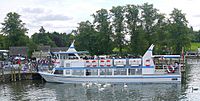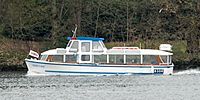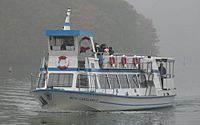Windermere Lake Cruises facts for kids
 |
|
| Private company | |
| Industry | Passenger transportation Leisure cruises |
| Predecessor | Bowness Bay Boating Company, Ambleside Motor Launch Company, Windermere Iron Steamboat Company, British Rail (Sealink) |
| Headquarters | Bowness-on-Windermere, Cumbria,
United Kingdom
|
|
Number of locations
|
3 |
|
Area served
|
Windermere |
| Services | Cruises and Self Drive Hire boats |
|
Number of employees
|
up to 150 |
| Parent | Winander Leisure Limited |
Windermere Lake Cruises is a company that offers fun boat trips on Windermere. This is England's largest natural lake, located in the beautiful Lake District. The company is based in Bowness-on-Windermere, Cumbria.
Contents
History of Windermere Boats
Windermere has always been a busy place for boats. In the early 1800s, sailing boats carried both people and goods along the lake. The very first steamship on any English lake was the Lady of the Lake. It launched in 1845.
Another company, the Windermere Iron Steamboat Company, started its own steamships. They launched the Firefly in 1847 and the Dragonfly in 1850. After some years of friendly competition, these two companies joined together in 1858. They became the Windermere United Yacht Company. This new company added more steamers, like the Rothay (1867) and the Swan (1869). The Rothay was the last paddle steamer built for the lake. All boats after that used propellers.
Railways and Lake Travel
In 1869, the Furness Railway opened a train line to Lakeside station. This station was designed so people could easily switch from trains to boats at the south end of the lake. The railway company soon took full control of the Windermere United Yacht Company in 1872.
The Furness Railway also bought a steam barge called the Raven in 1871. This boat carried cargo to homes and hotels around the lake. It also helped break ice in winter so passenger steamers could keep moving. Other boats added by the Furness Railway included the Cygnet (1879), Teal (1879), Tern (1891), Swift (1900), and Britannia (acquired in 1909).
Changes Over the Years
In 1923, many railway companies joined together. The lake steamers then came under the control of the London, Midland and Scottish Railway (LMS). The LMS built two new motor vessels for Windermere: the Teal (1936) and the Swan (1938). The old Raven was sold in 1927 and is now a museum exhibit. The older Teal and Swan boats were taken out of service.
In 1948, the Windermere steamers became part of British Rail. This happened when British railways were nationalised. By 1970, the Windermere boat service was known as Sealink Windermere.
In 1984, British Rail's shipping services were sold to a company called Sea Containers. They brought back the old name, Windermere Iron Steamboat Company, for the lake operations. Then, in 1993, a local company called Bowness Bay Boating Company bought the Windermere Iron Steamboat Company. They already had many boats on the lake. The two companies merged and became what we know today as Windermere Lake Cruises. The old Swift boat was taken out of service in 1999, but a brand new Swift joined the fleet in 2020.
How Windermere Lake Cruises Works
The main office for Windermere Lake Cruises is near the ferry pier in Bowness-on-Windermere. The boats are repaired and looked after at a special slipway at Lakeside and a dry dock at Waterhead.
The company has 17 passenger boats. Four of these are larger ships, often called "steamers," even though they now use diesel or diesel-electric power. There are also many smaller boats called launches. Plus, you can even rent your own self-drive boats!
Here are some of the services they offer:
| Name | Route | Description |
|---|---|---|
| Yellow | Bowness-on-Windermere – Lakeside Station – Bowness-on-Windermere | Runs all year; mostly uses the larger steamer boats. |
| Red | Bowness-on-Windermere – Windermere Jetty - (Brockhole National Park Visitor Centre) – Ambleside – Bowness-on-Windermere | Runs all year; uses both steamers and launches. Only launches and the Swift stop at Brockhole and Windermere Jetty. |
| Green | Ambleside – Brockhole National Park Visitor Centre – Wray Castle – Ambleside | Runs from March to October; uses smaller launch boats. |
| Blue | Bowness-on-Windermere - 45 Minute Circular Tour of the Islands - Bowness-on-Windermere | Runs all year; uses launch boats, with one daily trip by the Swift in summer. |
| Bike Boat | Brockhole National Park Visitor Centre – Bark Barn at Claife – Brockhole National Park Visitors Centre | Runs from May to September; uses a launch boat specially made to carry bicycles. |
| Ferry | Bowness-on-Windermere – Ferry House at Far Sawrey – Bowness-on-Windermere | Runs from March to October; uses a launch boat. |
| Ferry | Lakeside Station – Fell Foot Park – Lakeside Station | Runs from March to September; uses a launch boat. |
| Self Drive | Bowness-on-Windermere / Ambleside Waterhead | You can rent electric motor launches and rowing boats for yourself most of the year. |
The Fleet: Meet the Boats
The Windermere Lake Cruises fleet includes both large "steamers" and smaller "launches."
Steamers
These are the larger boats, even though they no longer use steam power.
Launches
These are the smaller, faster boats in the fleet.


